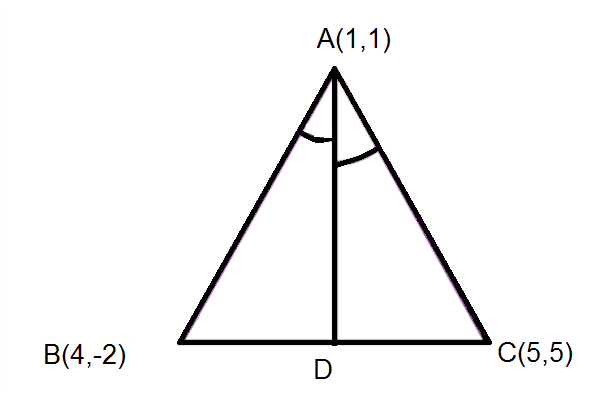
The vertices of the triangle are\[A\left( {1,{\rm{ }}1} \right),{\rm{ }}B\left( {4,{\rm{ }} - 2} \right)\]and \[C\left( {5,{\rm{ }}5} \right)\]. Find the equation of the perpendicular dropped from \[C\] to the interior bisector of the angle \[A\].
A. \[{\rm{y - 5 = 0}}\]
B. \[{\rm{ x - 5 = 0}}\]
C. \[{\rm{ y + 5 = 0}}\]
Answer
217.8k+ views
Hint: We are given the vertices of the triangle and we have to find the equation of the perpendicular. We will use the concept of slope in the given question. So firstly we will find the value of the slope and put it into the slope point form.
Formula used:
The following formula will be useful for this question
\[\begin{array}{l}{m_1}\; = {\rm{ }}\dfrac{{({y_2}\;-{\rm{ }}{y_1})}}{{({x_2}\;-{\rm{ }}{x_1})}}\\tan{\rm{ }}\alpha {\rm{ }} = {\rm{ }}\left| {\dfrac{{({m_1}\;-{\rm{ }}{m_2})}}{{(1{\rm{ }} + {\rm{ }}{m_1}{m_2})}}} \right|\\{m_1}{m_2}\; = {\rm{ }} - 1\end{array}\]
Complete step-by-step solution:

Image: The triangle having vertices\[A\left( {1,{\rm{ }}1} \right),{\rm{ }}B\left( {4,{\rm{ }} - 2} \right)\]and\[C\left( {5,{\rm{ }}5} \right)\]
Firstly we will find the slope of\[AC\]
\[\begin{array}{l}{m_1}\; = \dfrac{{\left( { - 2 - 1} \right)}}{{\left( {4 - 1} \right)}}\\{m_1} = \dfrac{{ - 3}}{3}\\{m_1} = - 1\end{array}\]
Now, we will find the slope of\[AC\]
\[\begin{array}{l}{m_2}\; = {\rm{ }}\dfrac{{\left( {5 - 1} \right)}}{{\left( {5 - 1} \right)}}\\{m_2}\; = 1\end{array}\]
Here, \[{m_1}{m_2}\; = {\rm{ }} - 1\]
So \[AC\] is perpendicular to\[AC\]
Let slope of bisector line \[AD = m\]
Since\[\angle A = {90^0}\]the angle between \[\;AD\] and\[AC\]is \[{45^0}\]
\[\begin{array}{l}tan{\rm{ }}\alpha {\rm{ }} = {\rm{ }}\left| {\dfrac{{({m_1}\;-{\rm{ }}{m_2})}}{{(1{\rm{ }} + {\rm{ }}{m_1}{m_2})}}} \right|\\\begin{array}{*{20}{l}}{tan{\rm{ }}45{\rm{ }} = {\rm{ }}\left| {\dfrac{{\left( {m{\rm{ }}-{\rm{ }}1} \right)}}{{\left( {1{\rm{ }} + {\rm{ }}m} \right)}}} \right|}\\{\dfrac{{\left( {m{\rm{ }}-{\rm{ }}1} \right)}}{{(1 + m)}} = {\rm{ }} \pm 1}\\{\dfrac{{\left( {m{\rm{ }}-{\rm{ }}1} \right)}}{{\left( {1 + {\rm{ }}m} \right)}} = 1{\rm{ }}or{\rm{ }}\dfrac{{\left( {m{\rm{ }}-{\rm{ }}1} \right)}}{{\left( {1 + {\rm{ }}m} \right)}} = - 1}\\{m{\rm{ }} = {\rm{ }}0}\end{array}\end{array}\]
This line will be parallel to the x-axis.
Then the slope of the perpendicular on \[AD,{\rm{ }}m = \infty \]
Equation of line is
\[\begin{array}{l}y{\rm{ }}-{\rm{ }}5{\rm{ }} = {\rm{ }}\left( {\dfrac{1}{0}} \right)\left( {x{\rm{ }}-{\rm{ }}5} \right)\\0 = x - 5\\x - 5 = 0\end{array}\]
Therefore, the option (B) is correct.
Additional Information: The slope, or rate of change along the regression line, is calculated by dividing the vertical distance between any two points on the line by the horizontal distance between those same two locations. When the product of the slope of two different lines is \[{\rm{ - 1}}\] then the two lines are perpendicular to each other and if the slope of two-line is the same then they are parallel to each other.
Note: Students generally make the mistake of finding the slope of the line. To avoid this, the slope and slope point form formula should be clear.
Formula used:
The following formula will be useful for this question
\[\begin{array}{l}{m_1}\; = {\rm{ }}\dfrac{{({y_2}\;-{\rm{ }}{y_1})}}{{({x_2}\;-{\rm{ }}{x_1})}}\\tan{\rm{ }}\alpha {\rm{ }} = {\rm{ }}\left| {\dfrac{{({m_1}\;-{\rm{ }}{m_2})}}{{(1{\rm{ }} + {\rm{ }}{m_1}{m_2})}}} \right|\\{m_1}{m_2}\; = {\rm{ }} - 1\end{array}\]
Complete step-by-step solution:

Image: The triangle having vertices\[A\left( {1,{\rm{ }}1} \right),{\rm{ }}B\left( {4,{\rm{ }} - 2} \right)\]and\[C\left( {5,{\rm{ }}5} \right)\]
Firstly we will find the slope of\[AC\]
\[\begin{array}{l}{m_1}\; = \dfrac{{\left( { - 2 - 1} \right)}}{{\left( {4 - 1} \right)}}\\{m_1} = \dfrac{{ - 3}}{3}\\{m_1} = - 1\end{array}\]
Now, we will find the slope of\[AC\]
\[\begin{array}{l}{m_2}\; = {\rm{ }}\dfrac{{\left( {5 - 1} \right)}}{{\left( {5 - 1} \right)}}\\{m_2}\; = 1\end{array}\]
Here, \[{m_1}{m_2}\; = {\rm{ }} - 1\]
So \[AC\] is perpendicular to\[AC\]
Let slope of bisector line \[AD = m\]
Since\[\angle A = {90^0}\]the angle between \[\;AD\] and\[AC\]is \[{45^0}\]
\[\begin{array}{l}tan{\rm{ }}\alpha {\rm{ }} = {\rm{ }}\left| {\dfrac{{({m_1}\;-{\rm{ }}{m_2})}}{{(1{\rm{ }} + {\rm{ }}{m_1}{m_2})}}} \right|\\\begin{array}{*{20}{l}}{tan{\rm{ }}45{\rm{ }} = {\rm{ }}\left| {\dfrac{{\left( {m{\rm{ }}-{\rm{ }}1} \right)}}{{\left( {1{\rm{ }} + {\rm{ }}m} \right)}}} \right|}\\{\dfrac{{\left( {m{\rm{ }}-{\rm{ }}1} \right)}}{{(1 + m)}} = {\rm{ }} \pm 1}\\{\dfrac{{\left( {m{\rm{ }}-{\rm{ }}1} \right)}}{{\left( {1 + {\rm{ }}m} \right)}} = 1{\rm{ }}or{\rm{ }}\dfrac{{\left( {m{\rm{ }}-{\rm{ }}1} \right)}}{{\left( {1 + {\rm{ }}m} \right)}} = - 1}\\{m{\rm{ }} = {\rm{ }}0}\end{array}\end{array}\]
This line will be parallel to the x-axis.
Then the slope of the perpendicular on \[AD,{\rm{ }}m = \infty \]
Equation of line is
\[\begin{array}{l}y{\rm{ }}-{\rm{ }}5{\rm{ }} = {\rm{ }}\left( {\dfrac{1}{0}} \right)\left( {x{\rm{ }}-{\rm{ }}5} \right)\\0 = x - 5\\x - 5 = 0\end{array}\]
Therefore, the option (B) is correct.
Additional Information: The slope, or rate of change along the regression line, is calculated by dividing the vertical distance between any two points on the line by the horizontal distance between those same two locations. When the product of the slope of two different lines is \[{\rm{ - 1}}\] then the two lines are perpendicular to each other and if the slope of two-line is the same then they are parallel to each other.
Note: Students generally make the mistake of finding the slope of the line. To avoid this, the slope and slope point form formula should be clear.
Recently Updated Pages
Arithmetic, Geometric & Harmonic Progressions Explained

Cartesian Form of Vector Explained: Formula, Examples & Uses

Apparent Frequency Explained: Formula, Uses & Examples

Calorimetry: Definition, Principles & Calculations

Centrifugal Force Explained: Definition, Formula & Examples

Charge in a Magnetic Field: Definition, Formula & Examples

Trending doubts
JEE Main 2026: Application Form Open, Exam Dates, Syllabus, Eligibility & Question Papers

Derivation of Equation of Trajectory Explained for Students

Hybridisation in Chemistry – Concept, Types & Applications

Understanding the Angle of Deviation in a Prism

Understanding Collisions: Types and Examples for Students

How to Convert a Galvanometer into an Ammeter or Voltmeter

Other Pages
JEE Advanced Marks vs Ranks 2025: Understanding Category-wise Qualifying Marks and Previous Year Cut-offs

NCERT Solutions for Class 11 Maths Chapter 10 Conic Sections

NCERT Solutions for Class 11 Maths Chapter 9 Straight Lines

NCERT Solutions For Class 11 Maths Chapter 8 Sequences And Series

NCERT Solutions For Class 11 Maths Chapter 12 Limits And Derivatives

Understanding Atomic Structure for Beginners




